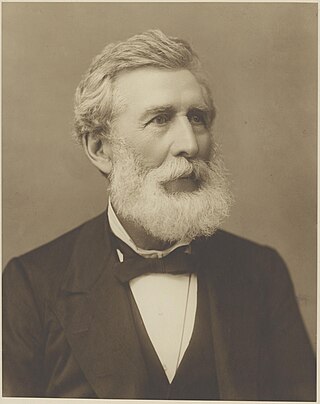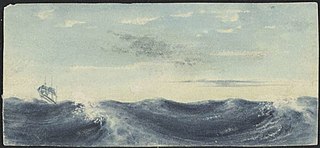Related Research Articles
Launceston may refer to:

Sir Adye Douglas was an Australian lawyer and politician, and first class cricket player, who played one match for Tasmania. He was Premier of Tasmania from 15 August 1884 to 8 March 1886.
The 30-ton sloop Rebecca was launched in 1834, built by Captain George Plummer at his boatyard on the banks of the Tamar River at Rosevears, Van Diemen's Land (Tasmania).

The Tasmanian Government Railways (TGR) was the former operator of the mainline railways in Tasmania, Australia. Formed in 1872, the railway company was managed by the Government of Tasmania, and existed until absorption into the Australian National Railways Commission in 1978.
The electoral division of Cornwall was an electoral division in the Tasmanian Legislative Council of Australia. It was abolished in 1999 after the Legislative Council was reduced from 19 members to 15.
Henry Elmes Lette was an Australian cricketer and politician. His middle name is frequently misreported as "Elms".

SS City of Launceston was a 368 GRT steamship operated by the Launceston and Melbourne Steam Navigation Company from 1863, which had an early role in colonial steam shipping as the forerunner of the modern Bass Strait ferry service between Tasmania and Victoria. It was sunk in Port Phillip Bay after a collision with another ship on 19 November 1865.

Hadspen is a town on the South Esk River in the north of Tasmania, Australia, 8 kilometres (5.0 mi) south west of Launceston. Hadspen has few commercial establishments and is primarily a residential suburb of nearby Launceston. Most of the town's buildings are residential, and relatively recent. The town's population of just over 2000 has grown rapidly from only a few hundred in the 1960s, and there are development plans that call for its doubling.

Mount Barrow is a mountain in the northern region of Tasmania, Australia. With an elevation of 1,406 metres (4,613 ft) above sea level, the mountain is located 22 kilometres (14 mi) east-north-east of Launceston. The mountain habitat is a mixture of temperate old growth rainforest, subalpine and alpine landscapes.
William Dodery was an Australian politician.

The Longford Railway Bridge is a railway bridge spanning the South Esk River, in Longford, Tasmania. The Western Railway Line travels over the bridge, enabling freight movement to/from the major Container ports of Burnie and Devonport and the rest of the state. In 1978, it was listed in the now-defunct Register of the National Estate.
The First Ayers Ministry was the 10th Ministry of the Government of South Australia, led by Henry Ayers. It commenced on 15 July 1863, when Ayers won support to form a ministry after the collapse of the First Dutton Ministry. In July 1864, the ministry was defeated on a motion of no confidence, but his opponents were unable to form government, and Ayers was sworn in heading the reconstituted Second Ayers Ministry on 22 July 1864.
On 11 and 12 February 1851, teams from Van Diemen's Land and Port Phillip District played the first cricket match between two Australian colonies, recognised in later years as the inaugural first-class cricket match in Australia. It took place at the Launceston Racecourse, known now as the NTCA Ground, in Tasmania. The match was incorporated into celebrations marking the separation of the Port Phillip District from New South Wales in 1851 as the colony of Victoria.

The Independent was a weekly English language newspaper published in Launceston, Tasmania from 1831 to 1835.

William Bannon was an Irishman who served in the British 65th Regiment of Foot in the New Zealand Wars in the 1840s. In 1849 he was found guilty of desertion and theft and was sentenced to transportation for seven years to Van Diemen's Land. A reward was posted for Bannon's capture after he escaped from a prison in Van Diemen's Land and, following his capture, he was transported to Norfolk Island before returning to Australia. "Murdering Gully Rd" at Table Cape, Tasmania is named after a murder that Bannon was accused of committing in 1858.
The Tamar Hematite Iron Company (THIC) was an iron mining and smelting company that operated from April 1874 to December 1877, in the area close to the location of the modern-day township of Beaconsfield, Tasmania, Australia.

Africaine was a barque launched in 1831 at Jarrow on the River Tyne in England. In 1836 she carried immigrants as part of the First Fleet of South Australia. She was wrecked on 23 September 1843.

PS Governor Wynyard, was a small steam ship, the first to be built in New Zealand, and was launched in 1851. She was a paddle steamer schooner, built of pohutukawa, with kauri planks. In 1853 she left her Tamaki River service in Auckland and was sold in Melbourne in 1852 during the gold rush, but was soon serving as a ferry in Tasmania, until she had her primitive engines removed in 1858. She sprang a leak and became a beached wreck in 1873.
Alfred Linly Norman, known as Linly Norman, was an English pianist and conductor who had a career in Australia before dying at an early age.
William Henry Breton was a lieutenant in the Royal Navy who wrote the memoirs Excursions in New South Wales, Western Australia and Van Dieman's Land, during the years 1830, 1831,1832 and 1833, first published in 1833 and Scandinavian Sketches, or, A Tour in Norway, published in 1835. The books resulted from private visits to Australia, or New Holland as it was then known, in 1829-30 and 1832-33 and to Norway, Sweden and Russia in 1834.
References
- ↑ "The Cornwall Chronicle". National Library of Australia. Retrieved 15 January 2014.